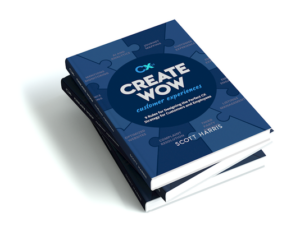During this year’s Experience2020 event, Experience.com (Formerly SocialSurvey)’s CEO Scott Harris helped attendees build the perfect CX strategy for their business during his opening keynote.
Event attendees included CX and Marketing professionals in a variety of different industries such as mortgage, insurance, real estate, hospitality, financial services, and more. So, how was Scott able to outline the perfect CX strategy that could be applied to all these businesses?
By acknowledging that they all have something in common – customers. Because we all have customers, he was able to focus on Voice of Customer (VOC) and use of that data together.
Here are the 8 rules needed to build your business perfect CX DATA strategy.
CX Data Strategy Rule #1: Start with the Organization
The first thing you should do is list anyone with a customer, including your channels, business units and departments. Once you’ve completed this list, identify the most seminal journey, the one that creates the most revenue or the most business outcomes. This is where your strategy will begin. Start by listing the following:
1. Different tiers of your organization. What is the structure of your company? From regions, to branches, to teams, to individuals, how is your company set up from a hierarchy perspective.
2. Customer touch points. Where do you interact with your customers? For example, implementation, support, renewal. Each industry is different, each customer is different, so list the specific touch points for your company.
3. Most impactful interactions. When you have the list of touch points, highlight the most important interactions. Where are the points on your customer journey where it is most critical you capture feedback?
CX Data Strategy Rule #2: Automate Data Collection
Manual processes mean that you miss out on valuable data, and potentially miss the most meaningful moments to collect it. The business outcomes for organizations that automate data collection can be 20 to 30 times what you get for people that try to do it manually. If you’re not collecting the right data, and you’re not doing it through an automated connection to your transaction system, it just won’t work to drive all the right outcomes.
With a full experience platform, like Experience.com (Formerly SocialSurvey), you can automate customer feedback requests during the most meaningful client interactions. With integrations to your transaction systems, you can remove the manual effort for each request. As soon as a client leaves the rental counter, or walks out of the loan office, immediately hit them with a survey request. This not only saves you time and energy, it ensures that every single interaction is captured and measured.
CTA: Write down how your current processes function. Do you have any automated processes?
CX Data Strategy Rule #3: Measure the Right Moments
Have you ever gotten a survey request days after an interaction, once you’ve already forgotten most of the details? Or even too early? The moment a company chooses to collect this feedback matters. So, think about the exact moments in your customer’s journey that would be most impactful to measure. If you run a retail business, maybe you set up automation that collects feedback immediately after your customer leaves the checkout counter. If your business deals with longer transactions like mortgage, you’ll likely have multiple moments to measure. Whichever model your business follows, selecting the most impactful moment(s) in the customer journey ensures data that matters!.
CTA: Get out your notepad, and write down each part of your customer’s journey from start to finish (be as detailed as possible). Put yourself in their shoes, and imagine the exact moments that would be most impactful to receive a review request (remember, there can be multiple).
CX Data Strategy Rule #4: Collect Measurement to People, Teams and Places
This is the most transformational rule there is – this is how you engage employees, gamify behavior and improve CX through automation. In order accomplish this you need to connect the measurement from rule #3 to the people providing the service to your customers.
AirBnB has a great example of how transformative this can be. AirBnB wanted to improve the check-in process for their guests, so they included a survey question asking guests “How was the check-in process?” They then connected this survey to the property host. Since positive reviews directly increase a host’s bookings, they were motivated to make the check-in process as enjoyable as possible to keep high ratings.
CTA: On your notepad, list out the behaviors of your employees that you would like to change or enhance. These behaviors could include more one call resolutions, a better check in experience or improved wait times – whatever behavior needed that will improve CX.
CX Data Strategy Rule #5: Automate Issue Escalation
As much as you put into customer experience, unhappy customers here and there are going to happen. What truly matters is that you have automated processes in place to handle it properly when it happens. Use the acronym C.A.R.E.— Collect the data, Apologize, Respond, Escalate. This automated workflow gives your company the opportunity to capture an unhappy customer and resolve the situation before they damage your online reputation. This creates accountability, engagement, and with automation, causes people to create better customer experiences as you improve behavior. [maybe delete last sentence]
CTA: Think of the last time you had an unhappy customer. How did you find out about their experience? Was it after they left a 1 star review on Google? Think about how you handled the situation, did you make it up to them?
CX Data Strategy Rule #6: Make Data-Driven Decisions
Before the evolution of CX, companies would send out long form surveys, which were then compiled into a report and left on the CEO’s desk to review. By the time any changes could be made from the data, it was too late. This model is not scalable for a business who wants to focus on CX. You can’t wait days or weeks to act on your customer data, it needs to be immediate. Especially in today’s buying landscape where consumers rely heavily on experiences when making buying decisions.
If you collect the data automatically from key moments in your customer’s journey then you will be able to make data driven decisions.
CTA: Think of the exact moment your data is collected. How long is it before you see that data? How long before you interact with that data?
CX Data Strategy Rule #7: Amplify your People, Locations & Brand
Your customer reviews shouldn’t be hidden in the CEO’s report. They should be shared on social media platforms like Facebook, LinkedIn, and Twitter, third party sites like Google, Zillow and Yelp and even your company’s website. They should be broadcasted everywhere possible. Amplifying your reviews like this will drive referrals through visibility on social media, allow you to win locally with increased ranking on Google and power your website’s SEO using the voice of your customer.
CTA: Count how many times you’ve shared a review on other platforms, be it social media, third party sites or your website. If that’s not a very difficult and long process for you, time to start sharing!
CX Data Strategy Rule #8: Automate Business Outcomes
If you can automatically collect data at the right moment in the customer journey and then automatically connect that data to behavior, you will be empowered with the information needed to make decisions that drive immediate business outcomes.
CX data is an asset and it should be considered as such. Every customer, every review, every feedback is an asset, and it should be your number one ROI.
With these 8 rules you’re ready to get started building your business’ perfect CX data strategy
Receive help with designing the perfect CX strategy for your business by scheduling a free whiteboarding session with one of our CX advisors.



















1 Comment
Comments are closed.